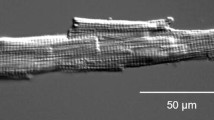Abstract
Cardiac function depends upon several factors, including adequate cellular mass, intact contractile machinery, and adequate production of ATP. An appropriate homeostasis on all these levels is crucial for the daunting life-long task the myocardium faces. Not surprisingly, many alterations in the above factors have been spotted when the heart fails and hypothesized to play a causal role in the genesis of the failing heart. Indeed, development of cardiac hypertrophy and failure is associated with chamber remodeling as well as with changes of the phenotype at the level of the individual myocyte. Disturbed energy metabolism with impaired fatty acid oxidation and lower expression of proteins involved in ATP synthesis occurs during myocardial hypertrophy and heart failure. The altered expression of proteins from metabolic pathways may reflect mitochondrial dysfunction as a feature of the transition from compensated myocardial hypertrophy with preserved fatty acid metabolism to impaired energy metabolism in heart failure.
Similar content being viewed by others
References
Bueno OF, van Rooij E, Molkentin JD, Doevendans PA, De Windt LJ (2002) Calcineurin and hypertrophic heart disease: novel insights and remaining questions. Cardiovasc Res 53:806–821
Bueno OF, Wilkins BJ, Tymitz KM, Glascock BJ, Kimball TF, Lorenz JN, Molkentin JD (2002) Impaired cardiac hypertrophic response in Calcineurin Abeta -deficient mice. Proc Natl Acad Sci USA 99:4586–4591
Degens H, de Brouwer KF, Gilde AJ, Lindhout M, Willemsen PH, Janssen BJ, van der Vusse GJ, van Bilsen M (2006) Cardiac fatty acid metabolism is preserved in the compensated hypertrophic rat heart. Basic Res Cardiol 101:17–26
Esposito G, Rapacciuolo A, Naga Prasad SV, Takaoka H, Thomas SA, Koch WJ, Rockman HA (2002) Genetic alterations that inhibit in vivo pressure-overload hypertrophy prevent cardiac dysfunction despite increased wall stress. Circulation 105:85–92
Fischer P, Hilfiker-Kleiner D (2007) Survival pathways in hypertrophy and heart failure: the gp130-STAT axis. Basic Res Cardiol 102:393–411
Grammer JB, Bleiziffer S, Monticelli F, Lange R, Bauernschmitt R (2006) Calcineurin and matrix protein expression in cardiac hypertrophy: evidence for calcineurin B to control excessive hypertrophic signaling. Basic Res Cardiol 101:292–300
Huber D, Grimm J, Koch R, Krayenbuehl HP (1981) Determinants of ejection performance in aortic stenosis. Circulation 64:126–134
Janczewski AM, Zahid M, Lemster BH, Frye CS, Gibson G, Higuchi Y, Kranias EG, Feldman AM, McTiernan CF (2004) Phospholamban gene ablation improves calcium transients but not cardiac function in a heart failure model. Cardiovasc Res 62:468–480
Kogler H, Schott P, Toischer K, Milting H, Van PN, Kohlhaas M, Grebe C, Kassner A, Domeier E, Teucher N, Seidler T, Knoll R, Maier LS, El-Banayosy A, Korfer R, Hasenfuss G (2006) Relevance of brain natriuretic peptide in preload-dependent regulation of cardiac sarcoplasmic reticulum Ca2+ ATPase expression. Circulation 113:2724–2732
Krayenbuehl HP, Hess OM, Ritter M, Monrad ES, Hoppeler H (1988) Left ventricular systolic function in aortic stenosis. Eur Heart J 9(Suppl E):19–23
Maack C, O’Rourke B (2007) Excitation–contraction coupling and mitochondrial energetics. Basic Res Cardiol 102:369–392
Molkentin JD (2004) Calcineurin-NFAT signaling regulates the cardiac hypertrophic response in coordination with the MAPKs. Cardiovasc Res 63:467–475
Molkentin JD, Lu JR, Antos CL, Markham B, Richardson J, Robbins J, Grant SR, Olson EN (1998) A calcineurin-dependent transcriptional pathway for cardiac hypertrophy. Cell 93:215–228
Munch G, Bolck B, Karczewski P, Schwinger RH (2002) Evidence for calcineurin-mediated regulation of SERCA 2a activity in human myocardium. J Mol Cell Cardiol 34:321–334
Perlini S, Muiesan ML, Cuspidi C, Sampieri L, Trimarco B, Aurigemma GP, Agabiti-Rosei E, Mancia G (2001) Midwall mechanics are improved after regression of hypertensive left ventricular hypertrophy and normalization of chamber geometry. Circulation 103:678–683
Sayen MR, Gustafsson AB, Sussman MA, Molkentin JD, Gottlieb RA (2003) Calcineurin transgenic mice have mitochondrial dysfunction and elevated superoxide production. Am J Physiol Cell Physiol 284:C562–C570
Schott P, Asif AR, Graf C, Toischer K, Hasenfuss G, Kogler H (2008) Myocardial adaptation of energy metabolism to elevated preload depends on calcineurin activity. A proteomic approach. Basic Res Cardiol
van Rooij E, Doevendans PA, Crijns HJ, Heeneman S, Lips DJ, van Bilsen M, Williams RS, Olson EN, Bassel-Duby R, Rothermel BA, De Windt LJ (2004) MCIP1 overexpression suppresses left ventricular remodeling and sustains cardiac function after myocardial infarction. Circ Res 94:e18–e26
Acknowledgments
Sources of Funding: Dr. De Windt is supported by grants 912-04-054, 912-04-017 and a VIDI award from the Netherlands Organization for Health Research and Development; and by the European Union Contract No. LSHM-CT-2005-018833/EUGeneHeart.
Author information
Authors and Affiliations
Corresponding author
Rights and permissions
About this article
Cite this article
Azzouzi, H.e., De Windt, L.J. Heart spotting. Basic Res Cardiol 103, 228–231 (2008). https://doi.org/10.1007/s00395-008-0698-z
Received:
Accepted:
Published:
Issue Date:
DOI: https://doi.org/10.1007/s00395-008-0698-z




